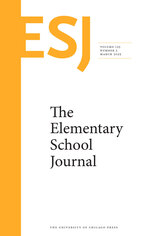102 books about Grammar & Punctuation and 12
start with A
102 books about Grammar & Punctuation and 12
102 books about Grammar & Punctuation
12 start with A start with A
12 start with A start with A
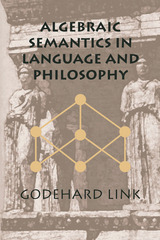
Algebraic Semantics in Language and Philosophy
Godehard Link
CSLI, 1997
The philosophical approach of this volume is mainly structuralist, using logical tools to investigate the formal structure of various kinds of objects in our world, as characterised by language and as systematised by philosophy. This volume mainly analyses the structural properties of collections or pluralities (with applications to the philosophy of set theory), homogeneous objects like water, and the semantics and philosophy of events. This book thereby complements algebraic work that has been done on other philosophical entities, i.e. propositions, properties, relations, or situations. Located in the triangle of language, logic and philosophy, this volume is unique in combining the resources of different ¹elds in an interdisciplinary enterprise. Half of the fourteen chapters of this volume are original papers, complementing the collection of the author's previously published essays on the subject.
[more]

Alternative Conceptions of Phrase Structure
Edited by Mark R. Baltin and Anthony S. Kroch
University of Chicago Press, 1989
In the early years of generative grammar it was assumed that the appropriate mechanism for generating syntactic structures was a grammar of context-free rewriting rules. The twelve essays in this volume discuss recent challenges to this classical formulation of phrase structure and the alternative conceptions proposed to replace it. Each article approaches this issue from the perspective of a different linguistic framework, such as categorical grammar, government-binding theory, head-driven phrase structure grammar, and tree-adjoining grammar. By contributing to the understanding of the differing assumptions and research strategies of each theory, this volume serves as an important survey of current thinking on the frontier of theoretical and computation linguistics.
[more]
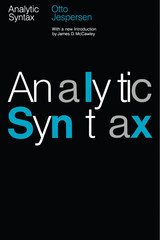
Analytic Syntax
Otto Jespersen
University of Chicago Press, 1984
Here the great Danish linguist Otto Jespersen puts forward his views on grammatical structure in a kind of shorthand formalism, devising symbols that represent various grammatical elements and then analyzing numerous sentences in terms of these symbols. The contemporaneity of these analyses is remarkable, for they allude to concepts that were uncongenial to linguists in 1937 when the book was first published, but which have come to be generally accepted in the linguistics community during the past twenty-five years.
[more]
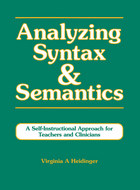
Analyzing Syntax & Semantics Textbook
Virginia Heidinger
Gallaudet University Press, 1984
This 22-chapter text explores the structure of language and the meaning of words within a given structure. The text/workbook combination gives students both the theory and practice they need to understand this complex topic.
Analyzing Syntax and Semantics features the Personalized System of Instruction (PSI) approach. This method uses student performance objectives, practice, feedback, individualization of pace, and repeatable testing as instructional strategies.
Analyzing Syntax and Semantics features the Personalized System of Instruction (PSI) approach. This method uses student performance objectives, practice, feedback, individualization of pace, and repeatable testing as instructional strategies.
[more]
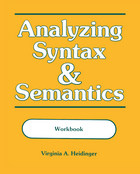
Analyzing Syntax & Semantics Workbook
Virginia Heidinger
Gallaudet University Press, 1984
This 22-chapter text explores the structure of language and the meaning of words within a given structure. The text/workbook combination gives students both the theory and practice they need to understand this complex topic.
Analyzing Syntax and Semantics features the Personalized System of Instruction (PSI) approach. This method uses student performance objectives, practice, feedback, individualization of pace, and repeatable testing as instructional strategies.
Analyzing Syntax and Semantics features the Personalized System of Instruction (PSI) approach. This method uses student performance objectives, practice, feedback, individualization of pace, and repeatable testing as instructional strategies.
[more]
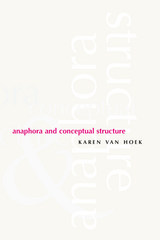
Anaphora and Conceptual Structure
Karen van Hoek
University of Chicago Press, 1997
Karen van Hoek presents a cogent analysis of the classic problem of constraints on pronominal anaphora within the framework of Cognitive Grammar. Van Hoek proceeds from the position that grammatical structure can be characterized in terms of semantic and phonological representations, without autonomous syntactic structures or principles such as tree structures or c-command. She argues that constraints on anaphora can be explained in terms of semantic interactions between nominals and the contexts in which they are embedded.
Integrating the results of previous work, Van Hoek develops a model in which some nominals function as "conceptual reference points" that dominate over stretches defined by the semantic relations among elements. When a full noun is in the domain of a reference point, coreference is ruled out, since the speaker would be sending contradictory messages about the salience of the noun's referent.
With profound implications for the nature of syntax, this book will interest theoretical linguists of all persuasions.
Integrating the results of previous work, Van Hoek develops a model in which some nominals function as "conceptual reference points" that dominate over stretches defined by the semantic relations among elements. When a full noun is in the domain of a reference point, coreference is ruled out, since the speaker would be sending contradictory messages about the salience of the noun's referent.
With profound implications for the nature of syntax, this book will interest theoretical linguists of all persuasions.
[more]
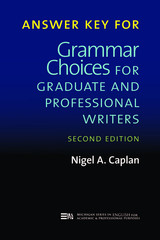
Answer Key for Grammar Choices for Graduate and Professional Writers, Second Edition
Nigel A. Caplan
University of Michigan Press, 2019
This answer key, available only as an ebook, is to be used with the Second Edition of Grammar Choices for Graduate and Professional Writers (Caplan, 2019, University of Michigan Press).
[more]
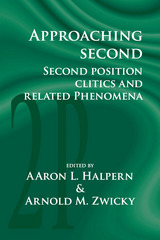
Approaching Second
Second Position Clitics and Related Phenomena
Arnold Zwicky
CSLI, 1996
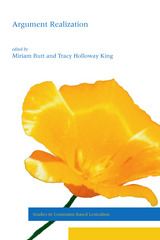
Argument Realization
Edited by Miriam Butt and Tracy Holloway King
CSLI, 2001

Arguments for a Non-Transformational Grammar
Richard A. Hudson
University of Chicago Press, 1976
For the past decade, the dominant transformational theory of syntax has produced the most interesting insights into syntactic properties. Over the same period another theory, systemic grammar, has been developed very quietly as an alternative to the transformational model. In this work Richard A. Hudson outlines "daughter-dependency theory," which is derived from systemic grammar, and offers empirical reasons for preferring it to any version of transformational grammar.
The goal of daughter-dependency theory is the same as that of Chomskyan transformational grammar—to generate syntactic structures for all (and only) syntactically well-formed sentences that would relate to both the phonological and the semantic structures of the sentences. However, unlike transformational grammars, those based on daughter-dependency theory generate a single syntactic structure for each sentence. This structure incorporates all the kinds of information that are spread, in a transformational grammar, over to a series of structures (deep, surface, and intermediate). Instead of the combination of phrase-structure rules and transformations found in transformational grammars, daughter-dependency grammars contain rules with the following functions: classification, dependency-marking, or ordering.
Hudson's strong arguments for a non-transformational grammar stress the capacity of daughter-dependency theory to reflect the facts of language structure and to capture generalizations that transformational models miss. An important attraction of Hudson's theory is that the syntax is more concrete, with no abstract underlying elements.
In the appendixes, the author outlines a partial grammar for English and a small lexicon and distinguishes his theory from standard dependency theory. Hudson's provocative thesis is supported by his thorough knowledge of transformational grammar.
The goal of daughter-dependency theory is the same as that of Chomskyan transformational grammar—to generate syntactic structures for all (and only) syntactically well-formed sentences that would relate to both the phonological and the semantic structures of the sentences. However, unlike transformational grammars, those based on daughter-dependency theory generate a single syntactic structure for each sentence. This structure incorporates all the kinds of information that are spread, in a transformational grammar, over to a series of structures (deep, surface, and intermediate). Instead of the combination of phrase-structure rules and transformations found in transformational grammars, daughter-dependency grammars contain rules with the following functions: classification, dependency-marking, or ordering.
Hudson's strong arguments for a non-transformational grammar stress the capacity of daughter-dependency theory to reflect the facts of language structure and to capture generalizations that transformational models miss. An important attraction of Hudson's theory is that the syntax is more concrete, with no abstract underlying elements.
In the appendixes, the author outlines a partial grammar for English and a small lexicon and distinguishes his theory from standard dependency theory. Hudson's provocative thesis is supported by his thorough knowledge of transformational grammar.
[more]
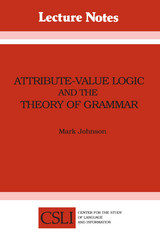
Attribute-Value Logic and the Theory of Grammar
Mark Johnson
CSLI, 1988
Because of the ease of their implementations, attribute-value nased theorires of grammar are becoming increasingly populaar in theoretical linguistics as an alternative to transformational accounts, as well as in computational linguistics. Mark Johnson provides a formal analysis of attribute-value structures, of their use in a theory of grammar, of the representation of grammatical relations in such theories of grammar, and the implications of different representations. A classical treatment of disjunction and negation is alo included.
"Essential reading for anyone interested in recent unification-based approcahes to grammar. Johnson lucidly lays out a formal framework in which a sharp distinction is drawn between descriptions of linguistic objects and the objects themselves. Negation and disjuntion over complex features, though linguistically desirable, have given rise to many problems, and one of Johnson's main achievements is to show that they can be interpreted using classic logic." -Ewan Klein, University of Edinburgh
MARK JOHNSON is assitant professor of cognitive and linguistic sciences at Brown University.
[more]
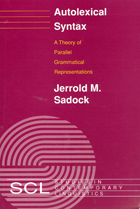
Autolexical Syntax
A Theory of Parallel Grammatical Representations
Jerrold M. Sadock
University of Chicago Press, 1990
In Autolexical Syntax, Jerrold M. Sadock argues for a radical departure from the derivational model of grammar that has prevailed in linguistics for thirty years. He offers an alternative theory in which the various components of grammar—in particular syntax, semantics, and morphology—are viewed as fully autonomous descriptive devices for various parallel dimensions of linguistic representation. The lexicon in this theory forges the connection between autonomous representations in that a typical lexeme plays a role in all three of the major components of the grammar.
Sadock's principal innovation is the postulation of a uniform set of interface conditions that require the several orthogonal representations of a single natural language expression to match up in certain ways. Through a detailed application of his theory to the twin morphosyntactic problems of cliticization and incorporation, Sadock shows that very straightforward accounts are made possible by the nonderivational model. He demonstrates the empirical success of these accounts by examining more than two dozen morphosyntactic problems in almost as many languages.
Autolexical Syntax will be of interest to those in the fields of theoretical grammar, particularly concerned with the problems of morphology and syntax, as well as philosophers of language, logicians, lexicographers, psychologists of language, and computer scientists.
Sadock's principal innovation is the postulation of a uniform set of interface conditions that require the several orthogonal representations of a single natural language expression to match up in certain ways. Through a detailed application of his theory to the twin morphosyntactic problems of cliticization and incorporation, Sadock shows that very straightforward accounts are made possible by the nonderivational model. He demonstrates the empirical success of these accounts by examining more than two dozen morphosyntactic problems in almost as many languages.
Autolexical Syntax will be of interest to those in the fields of theoretical grammar, particularly concerned with the problems of morphology and syntax, as well as philosophers of language, logicians, lexicographers, psychologists of language, and computer scientists.
[more]
READERS
Browse our collection.
PUBLISHERS
See BiblioVault's publisher services.
STUDENT SERVICES
Files for college accessibility offices.
UChicago Accessibility Resources
home | accessibility | search | about | contact us
BiblioVault ® 2001 - 2025
The University of Chicago Press




